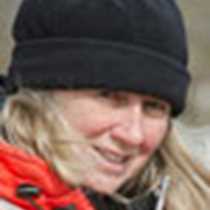Angkor Thom, Cambodia
Departure day definitely did not mean that we were ready to just pack it in and head to the airport. Siem Reap is the cradle of the Angkorian Empire and there was still a lot more to see.
Early morning light is so special with its golden tones. The air was crisp for a change, at least at 6:30am, as we zipped along in the back of tuk-tuks en route to Angkor Thom. The crowds were all going the opposite direction. Workers headed to their places of employment and children in their blue-and-white uniforms streamed into school. A few, like us, rode in the unique carriages pulled by a motor scooter but more were packed on scooters or on bicycles, sometimes four or even five of a family all on one. We were overjoyed that most of the tourists still had their heads resting on pillows or were lined up by the reflection pool of Angkor Wat. The sun was a red orb reflected in the surrounding moat as we passed that famous monument bound further afield to what once had been the largest city of the late 12th century, Angkor Thom.
Gods and demons faced off on opposite sides of the bridge leading to the gates of the city. Were they still churning the ocean as in the ancient myth? Inside majestic trees lined the roadway. Strangler figs wrapped their earth-seeking roots around robust Dipterocarpus trunks creating intriguing patterns. The strange white trunks of Lagerstroemia looked like muscular bundles topped by who-knows-what. They were so tall that seeing the canopy required an acrobatic act, so we just trusted that there were leaves on top.
A flock of honking geese escorted us to the gophura of Bayon, once the temple mountain of Angkor Thom. Piles of laterite and sandstone formed a confusing jumble inside the walls. One wonders how and if the puzzle will ever be reconstructed. Faces stared from every tower. Were they the bodhisattva Lokesvara looking to the four cardinal directions or a likeness of Jayavarman VII, the creator of the temple? Two hundred or more scattered here and there made sure that no corner went unobserved. Jayavarman’s two wives were present too, the favored obviously the most beautiful of all.
Galleries of intricate bas-reliefs told tales of life eight hundred years ago, their detailed records better than any historical account. Cham warriors battled Khmer from oar-powered vessels floating on rivers and lakes wherein swam fish that looked very much like those found in the Tonle Sap today. The story began with depictions of the quarrying of the stones that made this ancient temple and with a feast of pig and noodles too. Chinese merchants hawked their wares in markets much like those seen today and hunters needed to be wary for tigers prowled and crocodiles attacked. Birds perched in two-dimensional trees carved into the walls while in reality they sang from vegetated greenery surrounding us.
Nearby twelve Forbidden Towers (one for each year of the lunar calendar) lined the edges of the Elephant Terrace. One could envision the royal family and guests seated upon the broad rock wall watching demonstrations of hunting prowess. Inside the towers were there criminals awaiting the verdict of their guilt? Placed in the tower that corresponded to the year of their birth, the guilty one was the one who died first!
A haze seemed to wrap around these buildings, a sure sign that the day was heating up. We retraced our steps only to meet masses of visitors going the opposite way. How wise we were to choose the cool and quiet of the morning, along with the golden light.



